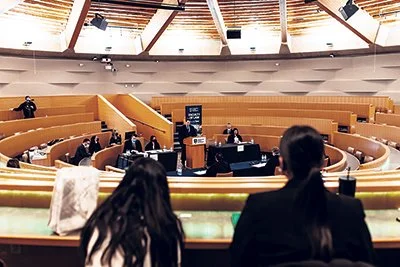Advancing a resource project from exploration to production requires steps that range from securing financial and community support to navigating regulatory requirements. Almost inevitably, the process is lengthy, with various factors determining progress.
Read MoreBranksome Hall is a leader in science, technology, engineering, arts and math (STEAM) education, with programs, curriculum and partnerships that foster creativity, problem-solving and critical thinking in its students.
Read MoreMany great performers have shared unforgettable moments with audiences at Massey Hall and Roy Thomson Hall in downtown Toronto. The Corporation of Massey Hall and Roy Thomson Hall, the not-for-profit organization that operates the iconic venues and additional performance spaces in Allied Music Centre, is leveraging the power of music to bring people together and help foster a more connected and understanding society.
Read MoreWith 4.4 million Canadian households living in core housing need, governments, non-profits and community providers cannot address the housing crisis alone. Now, an innovative new model promises to bring “socially inspired capital” to support greater investment in affordable housing.
Read MoreTranslating a language of life into novel diagnostic and therapeutic tools at Wilfrid Laurier University
What are some of the signals associated with the building blocks of life that enable our bodies to function? And how can better understanding them help us detect and address problems like cancer?
Read MoreThe Carney government has set ambitions for Canada to build the strongest economy in the G7 and to make mineral development and production a key driver of growth, positioning the country as a strategic supplier to allies. Industry groups say those goals depend on a robust exploration sector, where access to investment remains a persistent hurdle.
Read MoreVaccines of the future are taking shape today at the University of Saskatchewan’s Vaccine and Infectious Disease Organization (VIDO).
Read MorePressure on the health-care system – from factors including workforce shortages, rising costs and an aging population – is widely recognized among Canada’s most pressing and complex challenges.
Read MoreCorporate real estate (CRE) professionals from across North America will come together in Anaheim, California, October 27 to 29, for the 2025 CoreNet Global Summit, North America. These CRE practitioners will be sharing strategies for preparing for the future during a time of significant change. A key theme will be driving innovation amid shifting workforce needs, new economic pressures, and the heightened focus on sustainability and inclusivity in the buildings and other facilities in which employees work.
Read MoreDigital innovation is transforming all aspects of our society including provision of mental health care services. Telehealth and support systems based on artificial intelligence (AI) have emerged as promising new tools to expand access to mental health care and make it more affordable.
Read MorePost-secondary education, considered a key pathway to success, is widely acknowledged for the potential to boost quality of life and career flexibility for individuals, improve outcomes at community and business levels – and enhance Canada’s prosperity and competitiveness overall.
Read MoreWhat if you could donate to a charity of your choice and – at the same time – support the local resource industry?
Accelerating philanthropic impact and mineral exploration with flow-through share financing
Across Canada, there is a heightened focus on advancing resource sovereignty, with a spotlight on the critical minerals needed for energy security.
Read MoreWhen areas in Bedford, Nova Scotia, experienced more than 250 millimetres of rain in just days in July 2023, the resulting devastation caused country-wide alarm. Considered one of the highest impact flash floods in Canadian history, the incident served as a stark reminder how extreme weather events increasingly place communities at risk.
Read MoreEvidence-based approach empowers students to become ‘architects of their education’
Students at Havergal College are acquiring unique skills and knowledge through programs based on leading-edge educational research and novel approaches developed by faculty and an array of partners.
Read MoreClimate change will create new security challenges and magnify existing ones in Canada and around the world, according to a comprehensive defence review published by the government last year.
Read MoreStudents entering a law degree program have already proven their considerable intellectual capacity by obtaining a first degree, achieving a high grade-point average and passing the LSAT.
What awaits them at Thompson Rivers University (TRU) is a rigorous three-year, 60-credit course, where a strong foundation of knowledge of the law is complemented by ample opportunity to practise skills and competencies outside the classroom, says Daleen Millard, dean of TRU’s Faculty of Law.
Read More
How is the building materials industry preparing for a low-carbon future?
There has been a push to improve the environmental performance of the built environment, for example, through reducing embodied carbon in buildings as well as reducing the emissions associated with materials production. Our goal is to make buildings sustainable, so we offer lots of low-carbon solutions, including the world’s broadest range of green cement.
Read MoreWhen Ra’edah Abu Alhalaweh realized that breaking down barriers to follow a lifelong passion for fixing things around her home could also benefit her community, the obvious choice became to follow her dreams.
Read MoreBuffeted by external and internal pressures, Canada’s mineral industry faces a precarious moment. At a time of an escalating trade conflict with the U.S. and resulting economic uncertainty, the sector is also subject to intensifying tax pressures, stricter foreign investment rules and mounting regulatory challenges from within Canada.
Read More



















